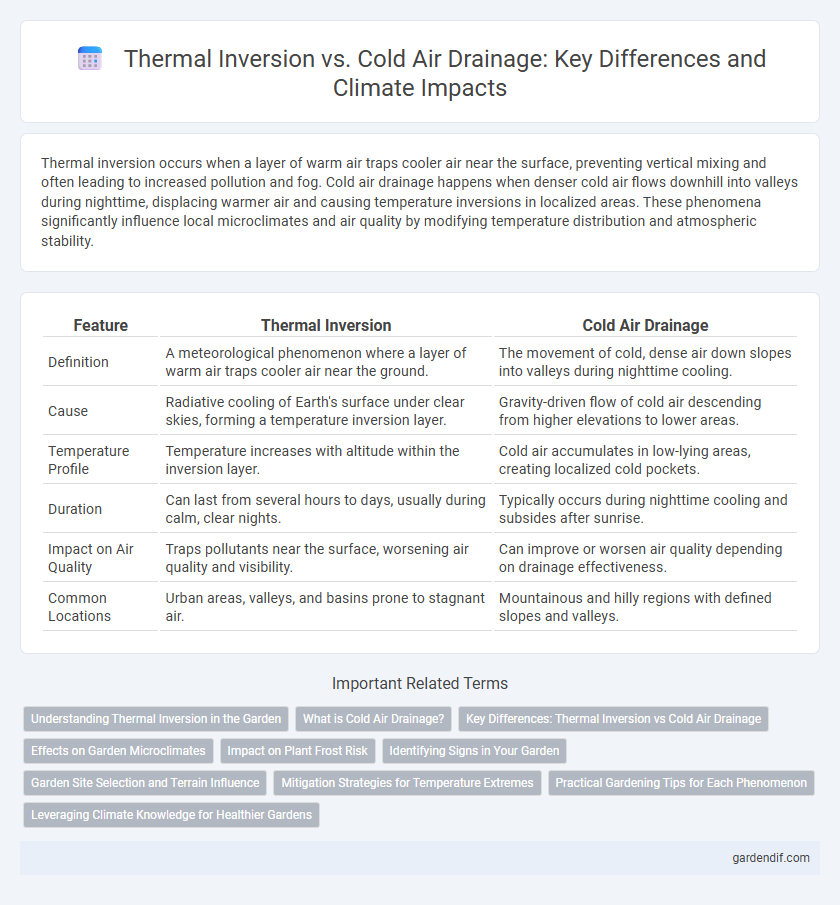
Thermal inversion vs Cold air drainage Illustration
Thermal inversion occurs when a layer of warm air traps cooler air near the surface, preventing vertical mixing and often leading to increased pollution and fog. Cold air drainage happens when denser cold air flows downhill into valleys during nighttime, displacing warmer air and causing temperature inversions in localized areas. These phenomena significantly influence local microclimates and air quality by modifying temperature distribution and atmospheric stability.
Table of Comparison
| Feature | Thermal Inversion | Cold Air Drainage |
|---|---|---|
| Definition | A meteorological phenomenon where a layer of warm air traps cooler air near the ground. | The movement of cold, dense air down slopes into valleys during nighttime cooling. |
| Cause | Radiative cooling of Earth's surface under clear skies, forming a temperature inversion layer. | Gravity-driven flow of cold air descending from higher elevations to lower areas. |
| Temperature Profile | Temperature increases with altitude within the inversion layer. | Cold air accumulates in low-lying areas, creating localized cold pockets. |
| Duration | Can last from several hours to days, usually during calm, clear nights. | Typically occurs during nighttime cooling and subsides after sunrise. |
| Impact on Air Quality | Traps pollutants near the surface, worsening air quality and visibility. | Can improve or worsen air quality depending on drainage effectiveness. |
| Common Locations | Urban areas, valleys, and basins prone to stagnant air. | Mountainous and hilly regions with defined slopes and valleys. |
Understanding Thermal Inversion in the Garden
Thermal inversion occurs when a layer of warm air traps cooler air near the garden surface, preventing normal vertical air movement and leading to higher concentrations of pollutants and frost risk. Cold air drainage refers to the movement of denser, cooler air descending into lower garden areas, often causing temperature variations that affect plant growth. Understanding these phenomena helps gardeners manage microclimates and protect sensitive plants from temperature extremes and air stagnation.
What is Cold Air Drainage?
Cold air drainage is a meteorological phenomenon where denser, cooler air flows downhill into lower elevations, often pooling in valleys during clear, calm nights. This process causes temperature inversions by trapping cooler air beneath a layer of warmer air, impacting local microclimates and increasing frost risk in agricultural regions. Understanding cold air drainage is crucial for predicting frost events and managing ecosystems in mountainous and hilly terrains.
Key Differences: Thermal Inversion vs Cold Air Drainage
Thermal inversion occurs when a layer of warm air traps cooler air beneath it, preventing vertical air movement and causing pollutants to accumulate near the surface. Cold air drainage happens when dense, cool air flows downslope into valleys or low-lying areas, displacing warmer air and often leading to frost formation. Unlike thermal inversion, which is characterized by temperature layering, cold air drainage is primarily driven by gravity and topography.
Effects on Garden Microclimates
Thermal inversion traps cold air beneath a layer of warm air, creating a stable microclimate that can protect delicate plants from frost in garden environments. Cold air drainage occurs when denser, cooler air flows downhill, accumulating in low-lying areas and increasing the risk of frost damage. Understanding these phenomena helps gardeners optimize plant placement to minimize cold stress and enhance growth conditions.
Impact on Plant Frost Risk
Thermal inversion traps a layer of warm air above cooler surface air, preventing vertical mixing and often leading to higher frost risk as cold air remains near the ground where plants are located. Cold air drainage occurs when denser, cooler air flows downhill and settles in low-lying areas, significantly increasing frost susceptibility in those microclimates by pooling colder temperatures around vegetation. Both phenomena create localized temperature gradients that exacerbate frost damage potential, critically affecting crop yields and plant health in vulnerable regions.
Identifying Signs in Your Garden
Thermal inversion often causes a layer of warm air to trap cooler air near the ground, resulting in stagnant, foggy conditions that can be detected by increased humidity and frost formation on plants. Cold air drainage occurs when denser, cooler air flows downhill, accumulating in low-lying areas and causing localized frost pockets and wilted foliage. Monitoring temperature variations, frost patterns, and humidity levels in your garden can help identify whether thermal inversion or cold air drainage is affecting your microclimate.
Garden Site Selection and Terrain Influence
Thermal inversion traps cold air beneath a layer of warm air, often leading to frost pockets that can damage sensitive plants, making site selection on elevated or well-drained slopes essential. Cold air drainage moves denser, cooler air downhill into valleys, meaning garden sites on gentle slopes or terraces above these drainage paths reduce frost risk and enhance microclimate stability. Terrain significantly influences both phenomena, with steep slopes promoting cold air outflow while flat valley bottoms increase the likelihood of thermal inversion and frost accumulation.
Mitigation Strategies for Temperature Extremes
Thermal inversion and cold air drainage both impact temperature extremes by trapping cold air in valleys or basins, leading to frost and freeze risks that require targeted mitigation strategies. Techniques such as enhancing vegetation cover, implementing windbreaks, and using controlled irrigation help disrupt inversion layers and promote air mixing, reducing temperature stress on crops and infrastructure. Urban planning that increases air circulation and avoids topographical traps also mitigates the severity of cold air pooling and associated thermal inversions.
Practical Gardening Tips for Each Phenomenon
Thermal inversion traps warm air above cooler surface air, often causing frost to linger in low-lying garden areas, so planting frost-sensitive species on higher ground can protect them. Cold air drainage funnels denser, cooler air downhill during nocturnal hours, creating frost pockets in valleys; using raised beds or installing frost cloths in these spots helps safeguard delicate plants. Employing windbreaks and selecting frost-hardy cultivars further mitigates damage in both thermal inversion and cold air drainage conditions.
Leveraging Climate Knowledge for Healthier Gardens
Thermal inversion traps cold air beneath a layer of warmer air, limiting air circulation and increasing pollutant concentration, while cold air drainage involves the flow of denser, cooler air down slopes into valleys, protecting plants from frost damage. Understanding these microclimate dynamics allows gardeners to optimize plant placement and irrigation strategies, reducing stress and disease risk. Leveraging this knowledge ensures healthier, more resilient gardens better adapted to local temperature variations.
Thermal inversion vs Cold air drainage Infographic

 gardendif.com
gardendif.com